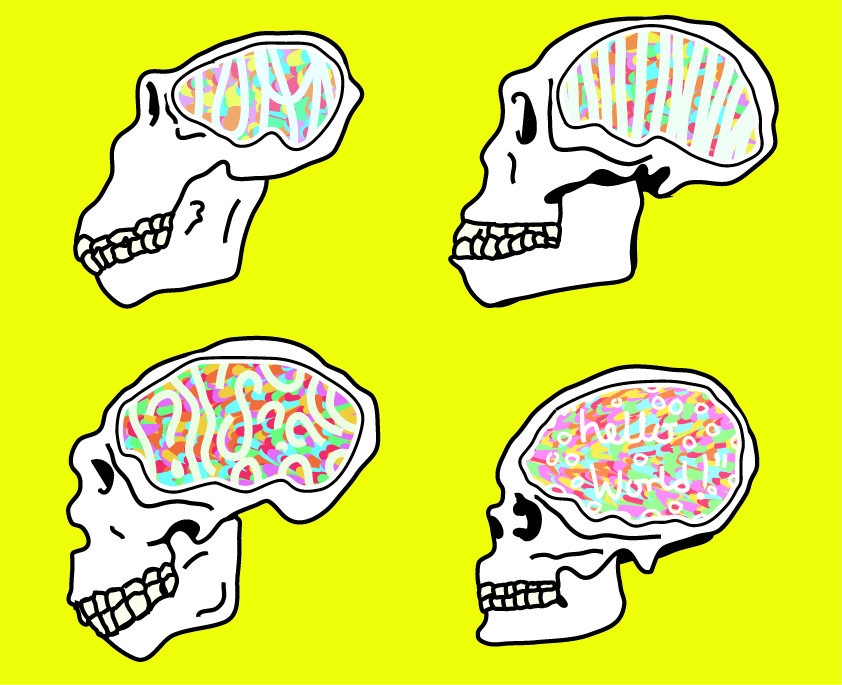SUNDAY, 11 FEBRUARY 2018
How is it that one species alone on this planet evolved language? Though we are not the only animal to have acquired a unique capability, language is so woven into the fabric of our species that it forms the defining element of our species-identity. For some, without language we would not even have concepts, and without concepts, we would not ‘think’ in the way that we understand thinking. It is part of our human condition. Undoubtedly, it qualifies as a ‘big question’ in science.Even so, are some questions too big to ask? The emergence and evolution of language is a difficult nut to even begin to crack, at least for now. Words do not fossilise, so we have no idea what ‘primitive’ language looked (or sounded) like. When no-one can think of a reason why language is not beneficial to a species’ fitness, explanations of how it evolved are open to a free-for-all. Marc Hauser is the author of influential work on human and non-human communication; in a recent publication he discusses the evolution of language and points out that:
“Often, perhaps too often, theoretical positions are staked out without considering the question of whether any evidence would really be able to support or refute the thesis.”
When asking such big questions, do we run the risk of getting carried away by possibilities rather than drawn in by the facts? On the other hand, is it overly pessimistic – defeatist even – to back down on something so obviously critical to our curiosity, not just about the world, but ourselves too?
What studies of language evolution need to explain is how the versatility and complexity of language came to be. Human speech (and sign language) as we know it is based on a huge store of thousands of abstract labels, or words. These are combined in meaningful ways, allowing the embedding of segments within other segments (recursivity) integrated with meaning-specific structural constraints (grammar). Together, these faculties enable us to communicate an essentially infinite variety of potential messages.
Investigating the evolution of a trait usually requires comparing across species and time, so as to look for continuities and contrasts and make inferences. Language, however, presents some specific problems.
 Language is, of course, still evolving. As communication becomes increasingly digital and global, short-hand ‘text-speak’ has become increasingly prolific and has evolved its own subtleties. For example ‘That’s okay.’ with a full stop and ‘That’s okay!’ relay different emotional information; the first can seem passive aggressive or hassled, the second gracious or even enthusiastic
Language is, of course, still evolving. As communication becomes increasingly digital and global, short-hand ‘text-speak’ has become increasingly prolific and has evolved its own subtleties. For example ‘That’s okay.’ with a full stop and ‘That’s okay!’ relay different emotional information; the first can seem passive aggressive or hassled, the second gracious or even enthusiasticAccording to Bickerton, the evolution of language is not only a question of language per se, but of the specific characteristics of our ancestors’ ecological niche that made language so fundamental to us in the first place. Other species, after all, do not seem to need to talk.
As for comparisons across time, we run into yet another problem. Except when written (and writing is a relatively modern invention), language leaves no traces. Richard Dawkins once argued, when offering an account of how something so complex as the eye could have occurred through evolution rather than by design, that a little sight is better than no sight at all. By the same token, one needs to prove why ‘a little language’ is better than ‘no language’, and why a ‘little more language’ is better still. Herein lies the essence of the problem of the scientific investigation into language evolution. How do you explain something so complex when you can only see its final state? For those who advocate the investigation of the evolution of language, such as Jim Hurford, linguist and author of numerous books on the topic, a chronology is beyond the horizon:
“I don’t think we can expect answers very soon about any timeline for language evolution, e.g. how many millennia ago various features of modern language(s) appeared. For example, I don’t think we can know how much of a language faculty Neanderthals had, or didn’t have.”
The difficulties with studying the evolution of human language in the same way as other traits may be insurmountable – at least for the time being.
Nevertheless, it is reasonable to conclude that progress on the big question has indeed been made. For example, while one would imagine intuitively that language evolved as we got better at communicating, Robbins Burling argues in his 2005 book The Talking Ape that at early stages the frontrunner of language was the ‘comprehender’ rather than the ‘speaker’. After all, what’s the point of being a language user if no-one else in the world can understand your message? At the same time, archaeological and physiological research offer evidence-based constraints on theorising, such as in regards to the vocal capacities of early hominids. Comparative cognition also continues to shed light on the abilities and limitations of non-human categorisation, social cognition, and communication. These can certainly be examined in the light of other non-human research and provide some clues as to what makes communication more or less common. For example, recent research points to corvid species – crows, jays, and others – as exhibiting complex behaviours that were once thought to be restricted to only our closest relatives, such as using tools to achieve otherwise unattainable goals, or appreciating the art of deception. What ties the ecological niche of chimps and corvids may provide clues to what ignited the breadth and complexity of cognitive abilities in our own species – possibly including language.
 Kanzi, a male Bonobo under the purview of Sue Savage-Rumbaugh, was the first great ape known to naturalistically learn how to use a lexigram through observing his mother interact with researchers, accompanying his pointing with high pitched vocalisations that may have been attempts to ape human speech
Kanzi, a male Bonobo under the purview of Sue Savage-Rumbaugh, was the first great ape known to naturalistically learn how to use a lexigram through observing his mother interact with researchers, accompanying his pointing with high pitched vocalisations that may have been attempts to ape human speechSteve Samuel is a postdoctoral researcher in comparative psychology at the Department of Psychology
Image credit: Thomas Hawk; Susan Murtaugh; Oran Maguire
